Abstract
The Enterobacter species E. aerogenes, E. cloacae, and E. hafnia were examined for resistance to penicillin and cephalosporin derivatives. All were resistant to benzyl penicillin, ampicillin, 6 [d(−)α-amino-p-hydroxyphenylacetamido] penicillanic acid, cephaloridine, cephalothin, and cephalexin. A significant number were sensitive to carbenicillin and 6 [d(−)α-carboxy-3-thienylacetamido] penicillanic acid. No differences among the three species were noted. The β-lactamase activity was cell-bound, and was not released by osmotic shock, toluene treatment, or diphenylamine treatment. It was rarely released into the growth medium. The β-lactamase activity was primarily directed against cephalosporin derivatives. Synthesis of β-lactamase was chromosomally mediated. Resistance to ampicillin seemed to be partly related to entry of the molecule into the bacteria since exposure to ethylenediaminetetraacetate lowered the minimal inhibitory concentration.
Full text
PDF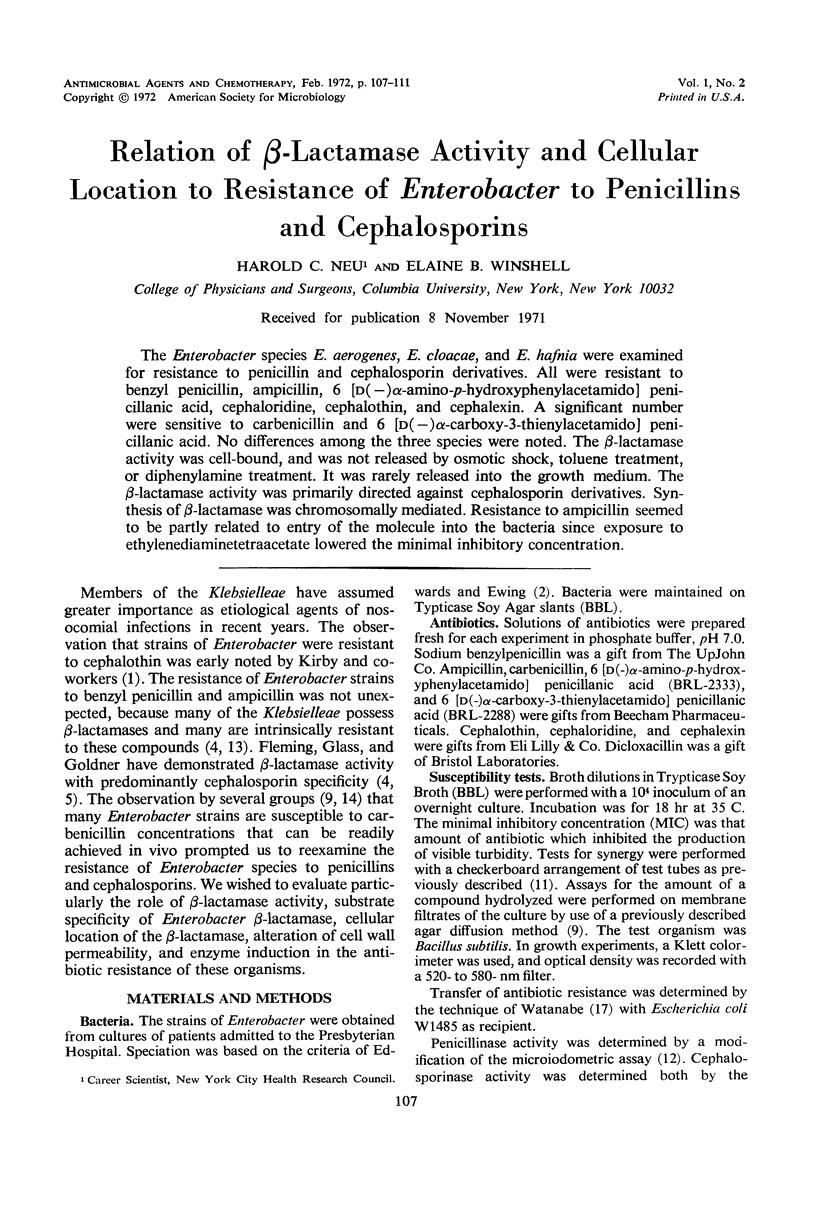
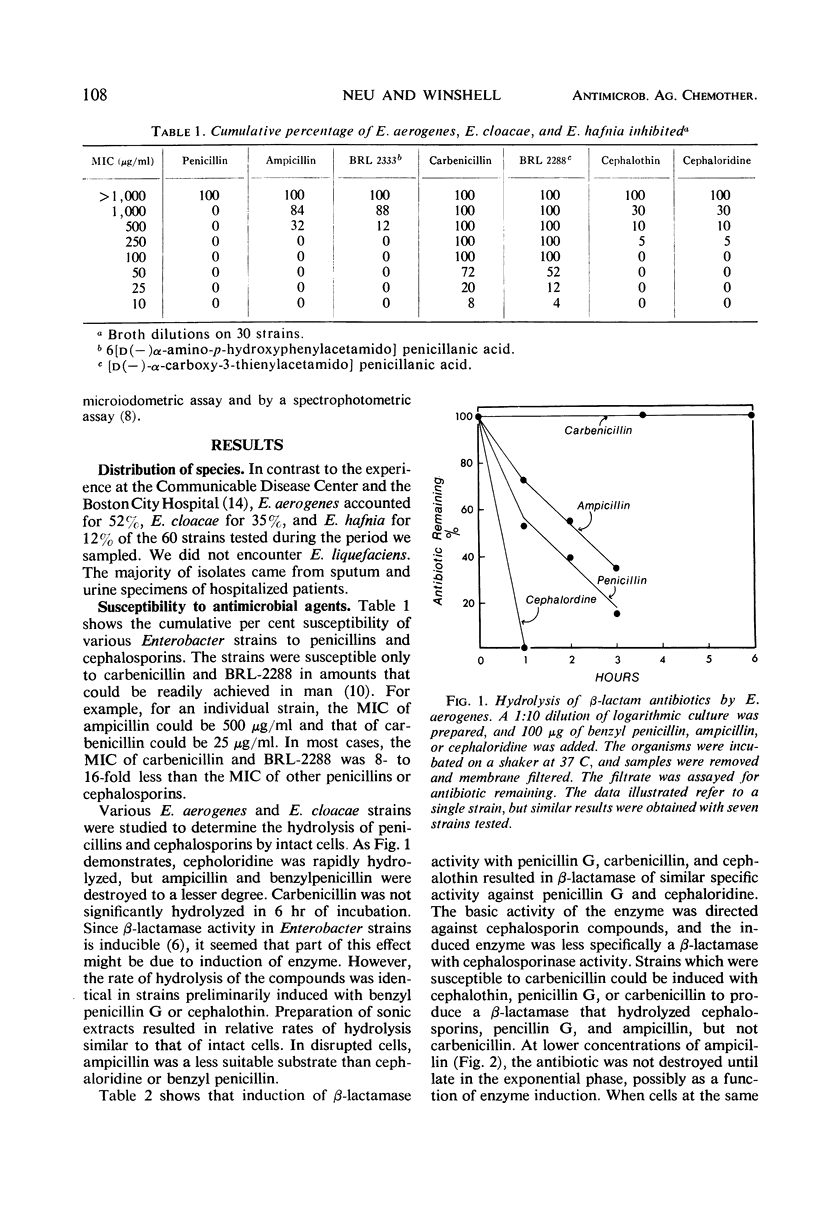
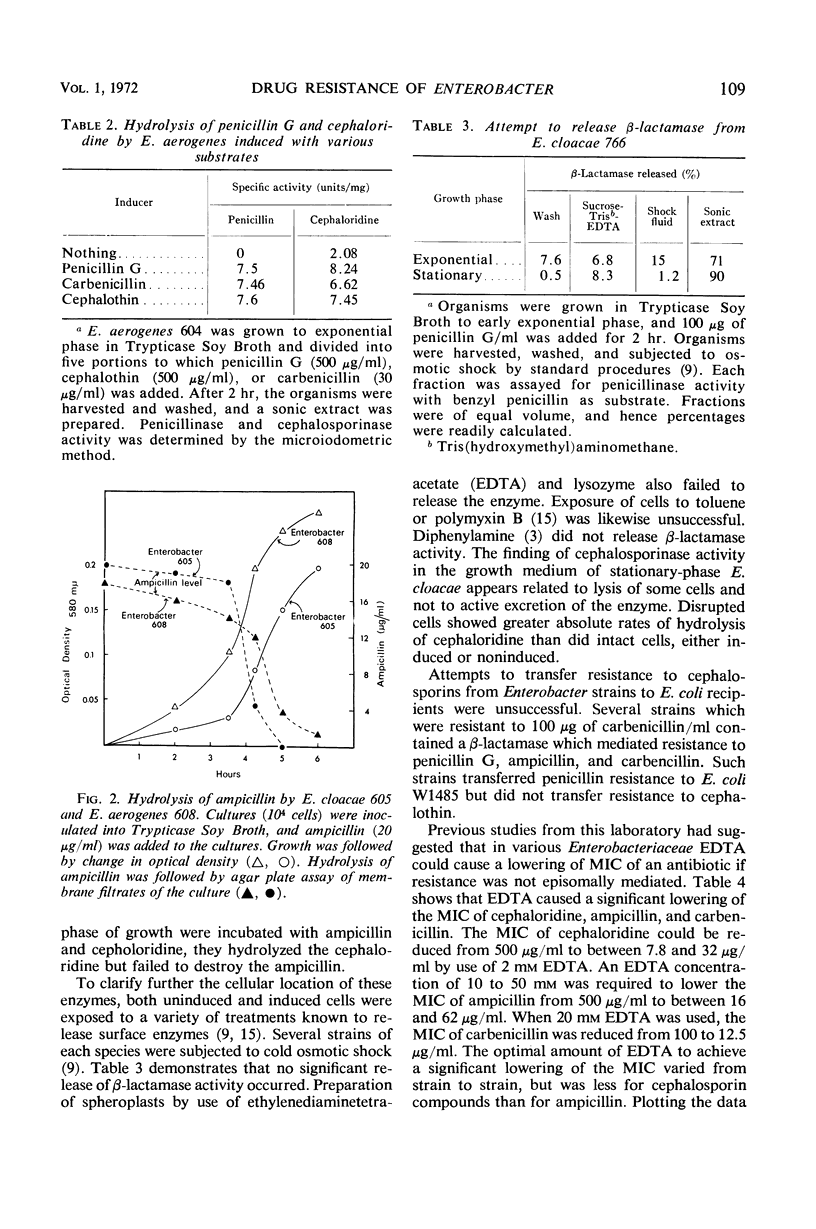
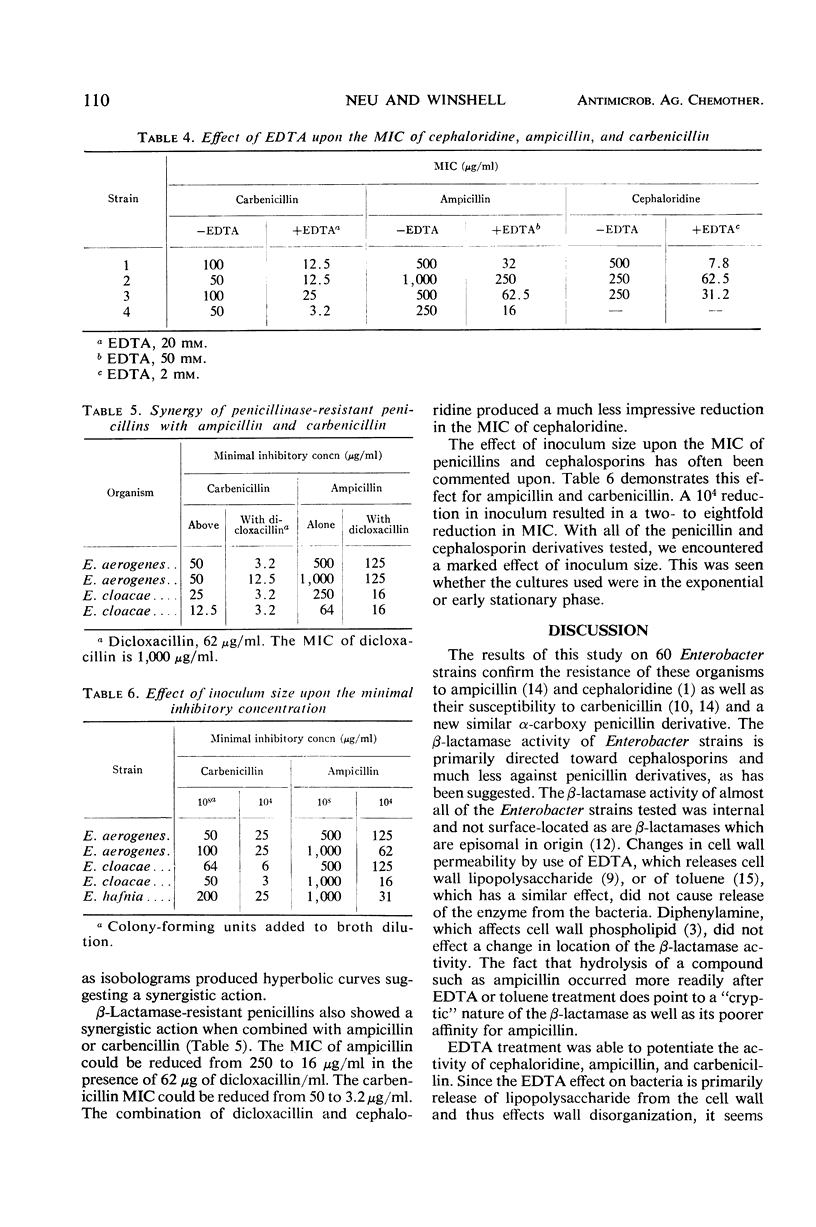
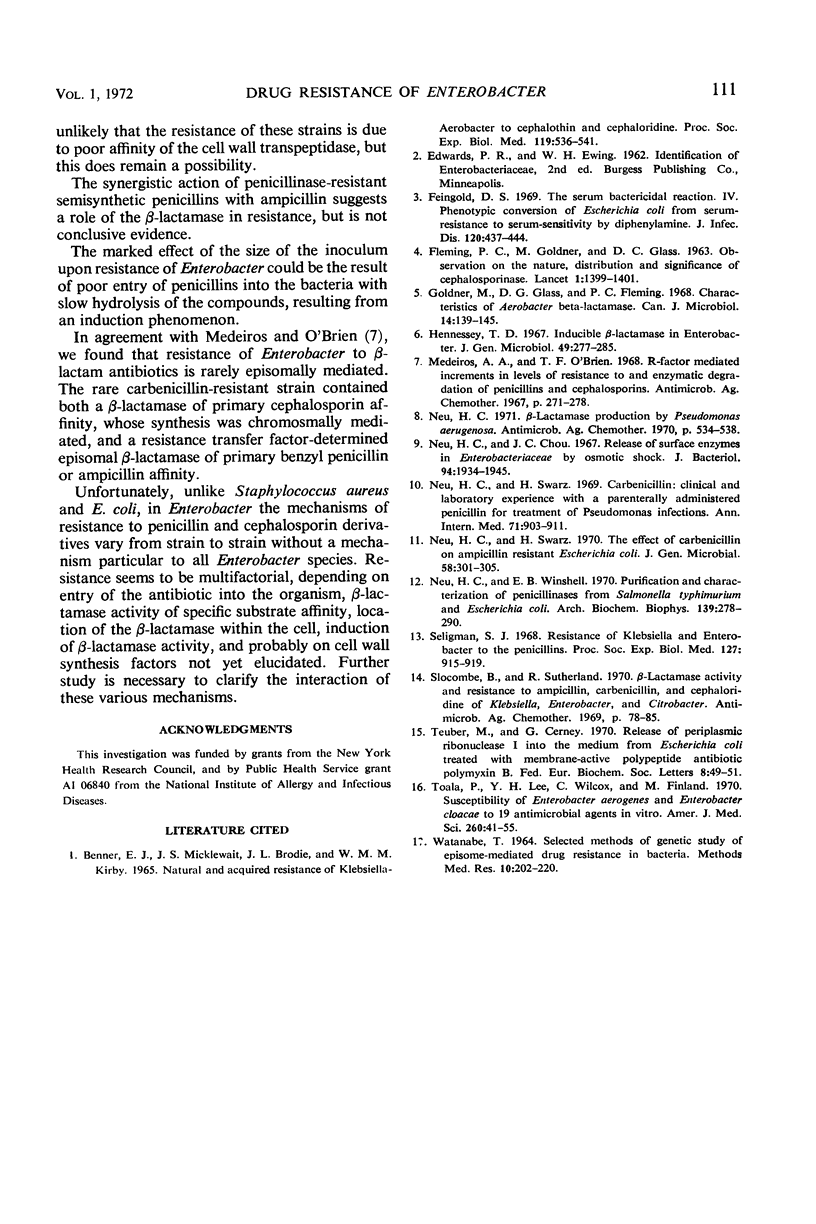
Selected References
These references are in PubMed. This may not be the complete list of references from this article.
- BENNER E. J., MICKLEWAIT J. S., BRODIE J. L., KIRBY W. M. NATURAL AND ACQUIRED RESISTANCE OF KLEBSIELLA-AEROBACTER TO CEPHALOTHIN AND CEPHALORIDINE. Proc Soc Exp Biol Med. 1965 Jun;119:536–541. doi: 10.3181/00379727-119-30231. [DOI] [PubMed] [Google Scholar]
- FLEMING P. C., GOLDNER M., GLASS D. G. Observations on the nature, distribution, and significance of cephalosporinase. Lancet. 1963 Jun 29;1(7296):1399–1401. doi: 10.1016/s0140-6736(63)92051-8. [DOI] [PubMed] [Google Scholar]
- Feingold D. S. The serum bactericidal reaction. IV. Phenotypic conversion of Escherichia coli from serum-resistance to serum-sensitivity by diphenylamine. J Infect Dis. 1969 Oct;120(4):437–444. doi: 10.1093/infdis/120.4.437. [DOI] [PubMed] [Google Scholar]
- Goldner M., Glass D. G., Fleming P. C. Characteristics of Aerobacter beta-lactamase. Can J Microbiol. 1968 Feb;14(2):139–145. doi: 10.1139/m68-023. [DOI] [PubMed] [Google Scholar]
- Hennessey T. D. Inducible beta-lactamase in Enterobacter. J Gen Microbiol. 1967 Nov;49(2):277–285. doi: 10.1099/00221287-49-2-277. [DOI] [PubMed] [Google Scholar]
- Medeiros A. A., O'Brien T. F. R factor-mediated increments in levels of resistance to and enzymatic degradation of penicillins and cephalosporins. Antimicrob Agents Chemother (Bethesda) 1967;7:271–278. doi: 10.1128/AAC.7.3.271. [DOI] [PubMed] [Google Scholar]
- Neu H. C. -lactamase production by Pseudomonas aeruginosa. Antimicrob Agents Chemother (Bethesda) 1970;10:534–538. [PubMed] [Google Scholar]
- Neu H. C., Chou J. Release of surface enzymes in Enterobacteriaceae by osmotic shock. J Bacteriol. 1967 Dec;94(6):1934–1945. doi: 10.1128/jb.94.6.1934-1945.1967. [DOI] [PMC free article] [PubMed] [Google Scholar]
- Neu H. C., Swarz H. Carbenicillin: clinical and laboratory experience with a parenterally administered penicillin for treatment of Pseudomonas infections. Ann Intern Med. 1969 Nov;71(5):903–911. doi: 10.7326/0003-4819-71-5-903. [DOI] [PubMed] [Google Scholar]
- Neu H. C., Swarz H. Resistance of Escherichia coli and Salmonella typhimurium to carbenicillin. J Gen Microbiol. 1969 Nov;58(3):301–305. doi: 10.1099/00221287-58-3-301. [DOI] [PubMed] [Google Scholar]
- Neu H. C., Winshell E. B. Purification and characterization of penicillinases from Salmonella typhimurium and Escherichia coli. Arch Biochem Biophys. 1970 Aug;139(2):278–290. doi: 10.1016/0003-9861(70)90479-0. [DOI] [PubMed] [Google Scholar]
- Seligman S. J. Resistance of Klebsiella and Enterobacter to the penicillins. Proc Soc Exp Biol Med. 1968 Mar;127(3):915–919. doi: 10.3181/00379727-127-32834. [DOI] [PubMed] [Google Scholar]
- Slocombe B., Sutherland R. Beta-lactamase activity and resistance to ampicillin, carbenicillin, and cephaloridine of Klebsiella, Enterobacter, and Citrobacter. Antimicrob Agents Chemother (Bethesda) 1969;9:78–85. [PubMed] [Google Scholar]
- Teuber M., Cerny G. Release of the periplasmic ribonuclease I into the medium from Escherichia coli treated with the membrane-active polypeptide antibiotic polymyxin B. FEBS Lett. 1970 May 11;8(1):49–51. doi: 10.1016/0014-5793(70)80222-8. [DOI] [PubMed] [Google Scholar]
- Toala P., Lee Y. H., Wilcox C., Finland M. Susceptibility of Enterobacter aerogenes and Enterobacter cloacae to 19 antimicrobial agents in vitro. Am J Med Sci. 1970 Jul;260(1):41–55. [PubMed] [Google Scholar]
- WATANABE T. SELECTED METHODS OF GENETIC STUDY OF EPISOME-MEDIATED DRUG RESISTANCE IN BACTERIA. Methods Med Res. 1964;10:202–220. [PubMed] [Google Scholar]


